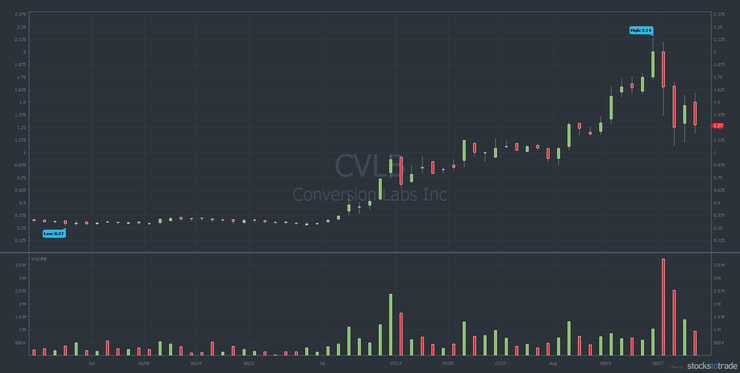Preparation is key. I say it all the time, but too many people aren’t getting it.
There’s a common statistic thrown around that says 90% of traders lose. Why do so many lose? Because they’re unprepared and they don’t follow rules. (I trade using these rules.)
Here’s a little wake-up call to anyone learning to trade penny stocks: You haven’t studied enough. You still haven’t figured out that preparation is key.
New to penny stocks? Start here with my FREE penny stock guide.
I constantly remind Trading Challenge students that preparation is key. Why? Because 90% of them aren’t studying enough.
The stock market is a battlefield. You don’t have the luxury of going into battle without being prepared. Study or get crushed. Read on for more about why preparation is key to success.
First, I want to share something I’m very proud of…
Stocks just had their best 100 days EVER so I’ve made $506k in trading profits, ALL donated to charity! While my charity @karmagawa announced a $1 million donation to Yemen, there‘s new crises in Lebanon, Mauritius & Bali so can you guess how much more $ we’re donating tomorrow? pic.twitter.com/AEd7VcshbS
— Timothy Sykes (@timothysykes) August 18, 2020
I’m happy to say I’m donating all $506,000 in profits as part of this…
Table of Contents
- 1 Karmagawa Announces $1.6 Million Donation for Yemen, Lebanon, Mauritius, and Indonesia
- 2 Trading Mentor: Questions From Students
- 3 Trading Lesson of the Week
- 4 Millionaire Mentor Market Wrap
Karmagawa Announces $1.6 Million Donation for Yemen, Lebanon, Mauritius, and Indonesia
We’re trying our best with several crises that all popped up at the same time. It’s our honor to donate badly needed funds and to spread awareness about the world’s most pressing issues. Karmagawa is donating to 15 charities with local teams on the ground.
The charities are:
Partners Relief, Bali Children’s Project, Unicef, Save The Children, Doctors Without Borders, Direct Relief, Mona Relief, World Food Program, IFAW, Four Paws International, Animals Lebanon, World Central Kitchen, Baitulmaal, Eco Sud, and Mauritian Wildlife Foundation.
Roughly $1 million is going to Yemen. We’re donating $100,000 to Bali for more schools, libraries, and food programs. Lebanon will get around $375,000. And Mauritius is getting around $125,000 to help clean up the oil spill.
Our fundraiser for Yemen has now ended. But you can still donate to our Mauritius and Lebanon fundraisers. Every donation adds up!
Donate to help clean up the oil spill in Mauritius here.
Donate to help the victims in Beirut, Lebanon here.
Why I Donate 100% of My Trading Profits to Charity
Remember, this isn’t about one person or one charity. It’s about teamwork. Mat Abad and I want to thank the community for all your support. Keep sharing and keep donating!
Now it’s time for…
Trading Mentor: Questions From Students
Each week I answer one or two questions from students. It’s my honor and duty to teach. My goal is to cut through all the BS and be the trading mentor to you that I never had.
Our focus this week is on preparation. Preparation is key because the market will keep giving opportunities. You just have to be ready.
The first question this week is about recognizing and adapting to shifting patterns…
“In a video lesson, you said, ‘the 11 a.m. bounce is a thing lately.’ What does that mean?”
First, you need to understand the morning panic pattern. Read my post “Try This Every Morning to Improve Your Mindset for Trading.” Even though that post is over a decade old, the same pattern is still happening.
Read “How to Dip Buy Morning Panics” for recent examples of the same pattern. It’s a pattern you should look for every day.
Back to the question…
Normally I like dip buying right near the market open. Often we get the bounce in the first five or 10 minutes. But lately, we’ve been seeing bounces later. That’s just something you have to adapt to.
I’ve mentioned the trend in several recent video lessons and webinars. I tried it on August 17. Check it out…
More Breaking News
- Why Inari Medical’s Stock Could Be the Next Big Thing
- Uber’s Strategic Moves: Will Stocks Soar in 2025?
- Cryptocurrency Surge: Will Coinbase Continue Its Upward Momentum?
Conversion Labs Inc (OTCQB: CVLB)
Conversion Labs has benefitted from the shift to virtual medical treatment. The company has a nationwide physician network and ships medications directly to patients.
Look at the CVLB three month chart below:

As you can see, CVLB was a multi-day runner leading into the morning panic on August 17. I thought it was a gimme given its recent strength.
Here’s the August 17 CVLB intraday chart with my trades:

My first trade was on the classic morning panic, but the bounce wasn’t as big as I expected. There were some big sellers on the ask, all in the $1.40s. I played it safe for a 5% win and $1,540 in profit.*
Testing the 11 a.m. Bounce
The second trade is an example of how a lot of dip buys have bounced later recently. I took a smaller position size due to the stock being scary. But it was a good patience trade based on the 11 a.m. bounce. It was a 6.34% win for another $540 in profit.*
(*Please note: My results, along with the results of my top students, are far from typical. Individual results will vary. Most traders lose money. My top students and I have the benefit of many years of hard work and dedication. Trading is inherently risky. Do your due diligence and never risk more than you can afford to lose.)
I probably should’ve held it longer, but it can be tough to be patient when you learn a pattern. Which is why I don’t teach people to just memorize patterns. You have to start understanding why it’s happening.
Why is the 11 a.m. bounce happening? Because so many people are looking for the dip buy right away and it’s becoming crowded. (Like how short selling became crowded but not nearly as risky.)
The thing to remember is that the pattern hasn’t disappeared. It’s just mutated a little.
Next question…
“You often say preparation is key. What’s your number-one preparation tip for both new and experienced traders?”

It’s all about learning a little bit every day. For example, learn to recognize pattern adaptations.
So you start by learning the initial patterns. Go through the 30-Day Bootcamp. All the basics are finally organized thanks to Matthew Monaco. Also, read “The Complete Penny Stock Course.” (Hint: it’s included in your 30-Day Bootcamp purchase.) Then watch the DVDs, webinars, and video lessons.
When you go through all the content my team and I put together, you’ll start to see the nuances and minor variations. Then you have to try to learn to adapt to changes as they happen.
So for those of you who like dip buys, you can start looking for the 11 a.m. bounce. Or even consider holding until 11 or 11:30 a.m. But don’t get too attached to it because it’ll likely shift again. You have to constantly test and tweak.
If you’re impatient, like me, you might like quicker bounces. Other people like shorting first red days.
Preparation Is Key: Find What Works Best for You
Preparation is all about you finding what works best for you. That’s why preparation is key.
Never forget that you can be wrong & lose on ANY trade, but your odds of success on any trade & especially over time are far greater when you find what setups work best FOR YOU & then focus on those few setups only. Try all strategies, weed out the ones that underperform FOR YOU!
— Timothy Sykes (@timothysykes) August 21, 2020
The market goes through hot periods and slower periods. Different sectors get hot. But it will always give opportunities — sometimes more and sometimes less. The question is … are you prepared?
You have to picture yourself almost like a batter in baseball. The market is the pitcher, and it will keep throwing pitches at you.
You have to figure out what you’re best at. Are you better at fastballs? Are you better at curveballs? Should you not swing sometimes?
Keep in mind … the market doesn’t care. The market will just keep throwing stuff out at you.
It’s your job to be prepared for as many pitches as possible.
Preparation Is Key When Trading Different Setups
A great example is Jack Kellogg. Jack took a big loss shorting Turtle Beach Corp (NASDAQ: HEAR) in May 2018. After that, he decided to stay away from he started tracking everything. He figured out what was working for him. As it turns out, it was only two patterns. He’d tried short selling for a while.
He focused on OTC long setups until he felt comfortable and could adapt. Then he slowly started working on shorting again.
Fast forward to today, and Jack’s a perfect example of how preparation meets opportunity. He can trade long or short. Sometimes he goes short and long on the same stock. It’s like he can swing and hit different pitches. (Do you think it helps that Jack wears his chain on the outside?)
Now it’s time for the…
Trading Lesson of the Week
This is a simple lesson, but too many people find it difficult…
Don’t Be Afraid NOT to Trade
Especially in August. Some of my top students made between $50,000 and $300,000 in June. It was capped off by that amazing CytoDyn Inc (OTCQB: CYDY) morning panic on June 30. Tim Grittani also gave an amazing webinar packed with lessons after his $272,000 win that day.*
Then July was a bit slower. Now August is slower again. I’ve still made $65,000 three-quarters of the way through the month.* So it’s not a terrible month. Actually, it’s stronger than most Augusts.
But at the same time … if you compare August to July it’s much slower. Compare August to June and it’s WAY slower. So you have to adapt.
Tim Grittani is on vacation right now. I don’t even know if he’s looking at a laptop. He’s already made $3.6 million this year.* So this is not a normal 9-to-5 job. You either adapt or perish.
How do you adapt? Preparation is key. I can’t emphasize that enough. You have to learn the basics and then gain enough experience trading small to adapt. That includes knowing when to step away. Sometimes the best trade is no trade.
Millionaire Mentor Market Wrap
That’s another one in the books. Use this last week of August to study — especially if it’s a slow week. Remember, preparation is key, so learn a little bit more every day. Study the past. Spend time building your knowledge account.
Also, start testing and tweaking different setups. Even if it means paper trading a new setup on StocksToTrade for a while. It gives you more options as the market shifts. Again, think of it like being able to hit different pitches.
Leave a comment below saying, “preparation is key, so I will study.” Also, tell me what you think of this post. I love to hear from all my readers!




Leave a reply